Human Bone Marrow Mesenchymal Stromal/Stem Cells Regulate the Proinflammatory Response of Monocytes and Myeloid Dendritic Cells from Patients with Rheumatoid Arthritis
Abstract
:1. Introduction
2. Materials and Methods
2.1. Collection of Peripheral Blood and Gradient Density Separation of PBMCs
2.2. Isolation of Human BM-MSCs
2.3. Co-Culture of PBMCs and BM-MSCs
2.4. Immunophenotypic Study of Monocyte Subsets and mDCs
2.4.1. Staining Protocol
2.4.2. Data Acquisition and Analysis
2.4.3. Identification and Characterization of PB mDCs and Classical, Intermediate, and Non-Classical Monocytes, by Flow Cytometry
2.5. Cell Purification of Classical Monocytes, Non-Classical Monocytes and mDCs
2.6. mRNA Expression in the Purified Cell Populations
2.7. Statistical Analyses
3. Results
3.1. BM-MSCs Hamper the Production of TNF-α and MIP-1β by Monocytes and mDCs from RA Patients and Healthy Individuals
3.2. Effect of BM-MSCs on mRNA Levels of CXCL9, CXCL10, CCL3, CCL5, and IL-1β, in Monocytes and mDCs from RA Patients and Healthy Individuals
3.3. BM-MSCs Reduce the Percentage of CCR7+ and CD83+ Monocytes and mDCs in RA Patients
4. Discussion
5. Conclusions
Author Contributions
Funding
Institutional Review Board Statement
Informed Consent Statement
Data Availability Statement
Acknowledgments
Conflicts of Interest
Appendix A
| Gender | Age | DAS28-CRP3v | CRP | ESR | TJC (0–28) | SJC (0–28) | Medication | Comorbidities | |||||
|---|---|---|---|---|---|---|---|---|---|---|---|---|---|
| MTX | HCQ | Sulfasalazine | Prednisolone | NSAIDs | |||||||||
| (Years) | (mg/dL) | (mm/h) | (mg/Week) | (mg/Day) | (mg/Day) | (mg/Day) | |||||||
| Patients with inactive RA * | |||||||||||||
| # 1 | F | 61 | 1.81 | 0.08 | 4 | 1 | 0 | 15 | 400 | 2000 | 5 | yes | Osteoporosis |
| # 2 | M | 50 | 2.39 | 0.47 | 19 | 0 | 0 | 25 | 0 | 2000 | 5 | no | None |
| # 3 | M | 47 | 1.21 | 0.12 | 4 | 0 | 0 | 15 | 0 | 0 | 2.5 | yes | None |
| # 4 | F | 52 | 1.68 | 0.1 | 5 | 0 | 1 | 15 | 0 | 0 | 1.25 | no | None |
| # 5 | F | 42 | 2.56 | 0.12 | 24 | 0 | 0 | 0 | 0 | 0 | 0 | no | None |
| # 6 | M | 38 | 0.68 | 0.2 | 2 | 0 | 0 | 10 | 0 | 2000 | 0 | no | None |
| # 7 | M | 55 | 2.5 | 0.34 | 15 | 0 | 1 | 0 | 400 | 2000 | 5 | yes | Dyslipidemia |
| Patients with active RA * | |||||||||||||
| # 8 | F | 60 | 4.65 | 1.92 | 30 | 6 | 8 | 25 | 400 | 3000 | 5 | no | None |
| # 9 | F | 41 | 5.63 | 5.4 | 70 | 9 | 14 | 0 | 0 | 3000 | 7.5 | yes | Depression |
| # 10 | F | 53 | 4.31 | 0.33 | 48 | 3 | 5 | 15 | 400 | 0 | 5 | yes | Obesity |
| # 11 | F | 71 | 3.91 | 4.25 | 40 | 0 | 12 | 25 | 400 | 2000 | 5 | yes | Hypertension, osteoporosis |
| # 12 | F | 59 | 6.08 | 1.15 | 72 | 11 | 5 | 0 | 0 | 0 | 5 | yes | Depression, dyslipidemia |
| HG | |||||||||||||
| # 1 | M | 50 | None | ||||||||||
| # 2 | F | 50 | None | ||||||||||
| # 3 | F | 50 | None | ||||||||||
| # 4 | F | 48 | None | ||||||||||
| # 5 | F | 35 | None | ||||||||||
| # 6 | F | 34 | None | ||||||||||
| Cytokine | Cell Type | Culture Conditions | Healthy Individuals | Inactive RA * | Active RA * | Total RA Patients |
|---|---|---|---|---|---|---|
| (n = 6) | (n = 5) | (n = 7) | (n = 12) | |||
| TNF-α | Classical monocytes | MNC + LPS + IFNγ | 85 ± 12 | 50 ± 9.4 | 68 ± 6.0 | 57 ± 12 |
| MNC + MSC + LPS + IFNγ | 39 ± 23 | 31 ± 15 | 42 ± 8.6 | 35 ± 14 | ||
| Intermediate monocytes | MNC + LPS + IFNγ | 81 ± 13 | 46 ± 11 | 66 ± 3.8 | 54 ± 13 | |
| MNC + MSC + LPS + IFNγ | 31 ± 14 | 26 ± 8.5 | 31 ± 7.3 | 28 ± 8.1 | ||
| Non-classical monocytes | MNC + LPS + IFNγ | 87 ± 7.5 | 47 ± 15 | 59 ± 19 | 52 ± 17 | |
| MNC + MSC + LPS + IFNγ | 61 ± 23 | 20 ± 10 | 35 ± 17 | 26 ± 15 | ||
| mDCs | MNC + LPS + IFNγ | 16 ± 7.4 | 9.8 ± 7.2 | 15 ± 6.7 | 12 ± 7.2 | |
| MNC + MSC + LPS + IFNγ | 4.2 ± 1.9 | 5.5 ± 2.6 | 8.6 ± 3.8 | 6.7 ± 3.3 | ||
| MIP-1β | Classical monocytes | MNC + LPS + IFNγ | 99 ± 0.8 | 94 ± 8.4 | 93 ± 4.2 | 94 ± 6.8 |
| MNC + MSC + LPS + IFNγ | 94 ± 3.7 | 81 ± 14 | 81 ± 9.1 | 81 ± 12 | ||
| Intermediate monocytes | MNC + LPS + IFNγ | 99 ± 0.9 | 90 ± 10 | 88 ± 8.7 | 89 ± 9.2 | |
| MNC + MSC + LPS + IFNγ | 80 ± 12 | 70 ± 15 | 65 ± 14 | 68 ± 14 | ||
| Non-classical monocytes | MNC + LPS + IFNγ | 92 ± 9.8 | 82 ± 18 | 73 ± 7.6 | 78 ± 15 | |
| MNC + MSC + LPS + IFNγ | 73 ± 17 | 57 ± 23 | 45 ± 20 | 52 ± 22 | ||
| mDCs | MNC + LPS + IFNγ | 17 ± 8.4 | 22 ± 11 | 13 ± 4.6 | 18 ± 9.5 | |
| MNC + MSC + LPS + IFNγ | 9.6 ± 5.8 | 12 ± 3.7 | 7.6 ± 1.6 | 10 ± 3.7 |
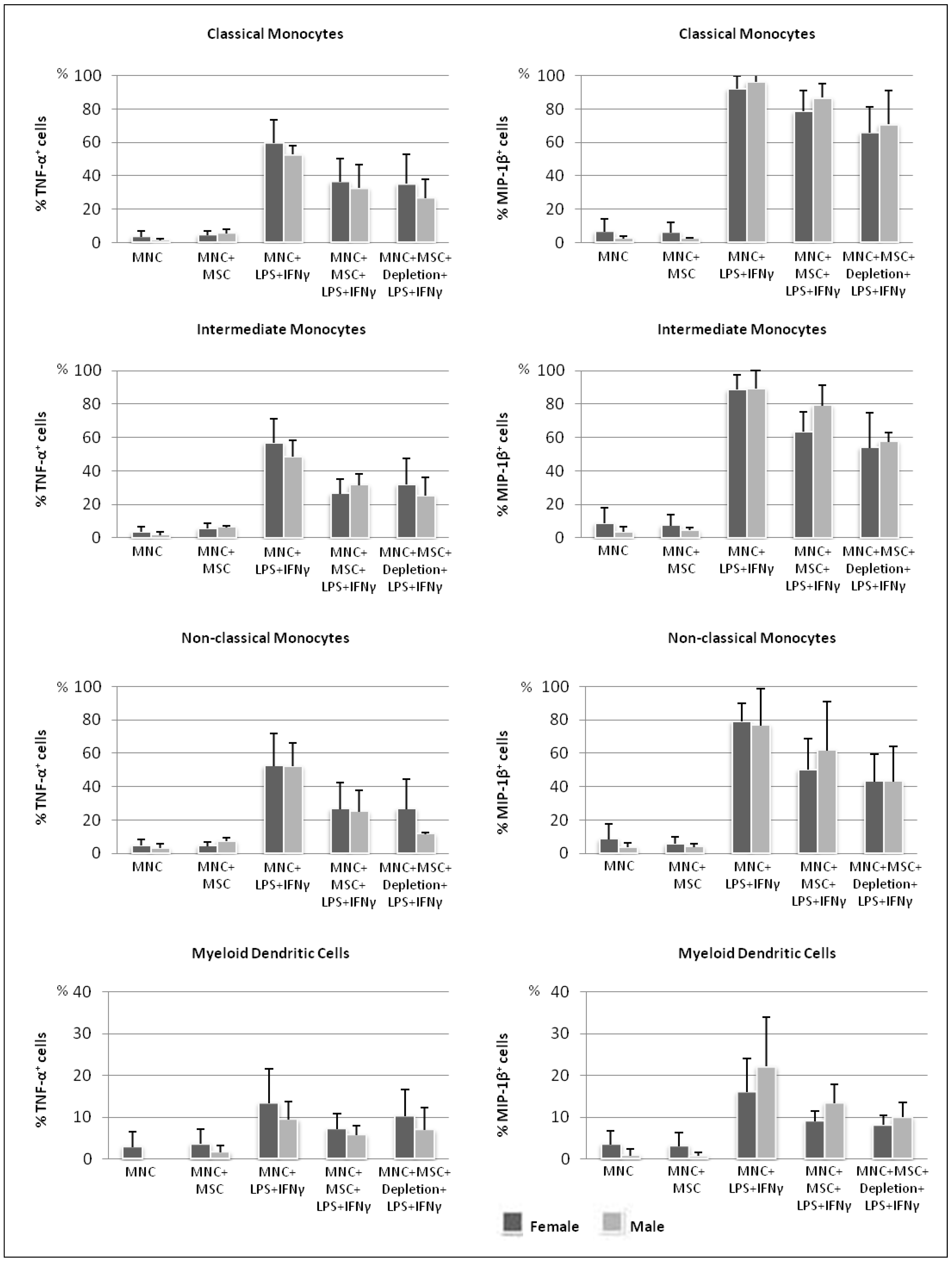
References
- Smolen, J.S.; Aletaha, D.; McInnes, I.B. Rheumatoid arthritis. Lancet 2016, 388, 2023–2038. [Google Scholar] [CrossRef]
- Boissier, M.C.; Semerano, L.; Challal, S.; Saidenberg-Kermanac’h, N.; Falgarone, G. Rheumatoid arthritis: From autoimmunity to synovitis and joint destruction. J. Autoimmun. 2012, 39, 222–228. [Google Scholar] [CrossRef]
- Buckley, C.D.; McGettrick, H.M. Leukocyte trafficking between stromal compartments: Lessons from rheumatoid arthritis. Nat. Rev. Rheumatol. 2018, 14, 476–487. [Google Scholar] [CrossRef] [PubMed]
- Firestein, G.S. Evolving concepts of rheumatoid arthritis. Nature 2003, 423, 356–361. [Google Scholar] [CrossRef] [PubMed]
- Gonzalez, M.A.; Gonzalez-Rey, E.; Rico, L.; Buscher, D.; Delgado, M. Treatment of experimental arthritis by inducing immune tolerance with human adipose-derived mesenchymal stem cells. Arthritis Rheumatol. 2009, 60, 1006–1019. [Google Scholar] [CrossRef]
- Noack, M.; Miossec, P. Selected cytokine pathways in rheumatoid arthritis. Semin. Immunopathol. 2017, 39, 365–383. [Google Scholar] [CrossRef] [PubMed]
- Minozzi, S.; Bonovas, S.; Lytras, T.; Pecoraro, V.; Gonzalez-Lorenzo, M.; Bastiampillai, A.J.; Gabrielli, E.M.; Lonati, A.C.; Moja, L.; Cinquini, M.; et al. Risk of infections using anti-TNF agents in rheumatoid arthritis, psoriatic arthritis, and ankylosing spondylitis: A systematic review and meta-analysis. Expert Opin. Drug Saf. 2016, 15, 11–34. [Google Scholar] [CrossRef]
- Lipsky, P.E.; van der Heijde, D.M.; St Clair, E.W.; Furst, D.E.; Breedveld, F.C.; Kalden, J.R.; Smolen, J.S.; Weisman, M.; Emery, P.; Feldmann, M.; et al. Infliximab and methotrexate in the treatment of rheumatoid arthritis. Anti-Tumor Necrosis Factor Trial in Rheumatoid Arthritis with Concomitant Therapy Study Group. N. Engl. J. Med. 2000, 343, 1594–1602. [Google Scholar] [CrossRef] [Green Version]
- Park, E.H.; Lim, H.S.; Lee, S.; Roh, K.; Seo, K.W.; Kang, K.S.; Shin, K. Intravenous Infusion of Umbilical Cord Blood-Derived Mesenchymal Stem Cells in Rheumatoid Arthritis: A Phase Ia Clinical Trial. Stem Cells Transl. Med. 2018, 7, 636–642. [Google Scholar] [CrossRef] [Green Version]
- Liang, J.; Zhang, H.; Hua, B.; Wang, H.; Lu, L.; Shi, S.; Hou, Y.; Zeng, X.; Gilkeson, G.S.; Sun, L. Allogenic mesenchymal stem cells transplantation in refractory systemic lupus erythematosus: A pilot clinical study. Ann. Rheum. Dis. 2010, 69, 1423–1429. [Google Scholar] [CrossRef] [Green Version]
- Li, X.; Wang, D.; Liang, J.; Zhang, H.; Sun, L. Mesenchymal SCT ameliorates refractory cytopenia in patients with systemic lupus erythematosus. Bone Marrow Transpl. 2013, 48, 544–550. [Google Scholar] [CrossRef] [PubMed]
- Wang, D.; Akiyama, K.; Zhang, H.; Yamaza, T.; Li, X.; Feng, X.; Wang, H.; Hua, B.; Liu, B.; Xu, H.; et al. Double allogenic mesenchymal stem cells transplantations could not enhance therapeutic effect compared with single transplantation in systemic lupus erythematosus. Clin. Dev. Immunol. 2012, 2012, 273291. [Google Scholar] [CrossRef]
- Karussis, D.; Karageorgiou, C.; Vaknin-Dembinsky, A.; Gowda-Kurkalli, B.; Gomori, J.M.; Kassis, I.; Bulte, J.W.; Petrou, P.; Ben-Hur, T.; Abramsky, O.; et al. Safety and immunological effects of mesenchymal stem cell transplantation in patients with multiple sclerosis and amyotrophic lateral sclerosis. Arch. Neurol. 2010, 67, 1187–1194. [Google Scholar] [CrossRef]
- Connick, P.; Kolappan, M.; Crawley, C.; Webber, D.J.; Patani, R.; Michell, A.W.; Du, M.Q.; Luan, S.L.; Altmann, D.R.; Thompson, A.J.; et al. Autologous mesenchymal stem cells for the treatment of secondary progressive multiple sclerosis: An open-label phase 2a proof-of-concept study. Lancet Neurol. 2012, 11, 150–156. [Google Scholar] [CrossRef] [Green Version]
- Alvaro-Gracia, J.M.; Jover, J.A.; Garcia-Vicuna, R.; Carreno, L.; Alonso, A.; Marsal, S.; Blanco, F.; Martinez-Taboada, V.M.; Taylor, P.; Martin-Martin, C.; et al. Intravenous administration of expanded allogeneic adipose-derived mesenchymal stem cells in refractory rheumatoid arthritis (Cx611): Results of a multicentre, dose escalation, randomised, single-blind, placebo-controlled phase Ib/IIa clinical trial. Ann. Rheum. Dis. 2017, 76, 196–202. [Google Scholar] [CrossRef]
- Ansboro, S.; Roelofs, A.J.; De Bari, C. Mesenchymal stem cells for the management of rheumatoid arthritis: Immune modulation, repair or both? Curr. Opin. Rheumatol. 2017, 29, 201–207. [Google Scholar] [CrossRef]
- Bouffi, C.; Bony, C.; Courties, G.; Jorgensen, C.; Noel, D. IL-6-dependent PGE2 secretion by mesenchymal stem cells inhibits local inflammation in experimental arthritis. PLoS ONE 2010, 5, e14247. [Google Scholar] [CrossRef] [PubMed]
- Abdelmawgoud, H.; Saleh, A. Anti-Inflammatory and antioxidant effects of mesenchymal and hematopoietic stem cells in a rheumatoid arthritis rat model. Adv. Clin. Exp. Med. 2018, 27, 873–880. [Google Scholar] [CrossRef] [PubMed]
- Laranjeira, P.; Gomes, J.; Pedreiro, S.; Pedrosa, M.; Martinho, A.; Antunes, B.; Ribeiro, T.; Santos, F.; Domingues, R.; Abecasis, M.; et al. Human Bone Marrow-Derived Mesenchymal Stromal Cells Differentially Inhibit Cytokine Production by Peripheral Blood Monocytes Subpopulations and Myeloid Dendritic Cells. Stem Cells Int. 2015, 2015, 819084. [Google Scholar] [CrossRef] [Green Version]
- Laranjeira, P.; Pedrosa, M.; Pedreiro, S.; Gomes, J.; Martinho, A.; Antunes, B.; Ribeiro, T.; Santos, F.; Trindade, H.; Paiva, A. Effect of human bone marrow mesenchymal stromal cells on cytokine production by peripheral blood naive, memory, and effector T cells. Stem Cell Res. Ther. 2015, 6, 3. [Google Scholar] [CrossRef] [Green Version]
- Pedrosa, M.; Gomes, J.; Laranjeira, P.; Duarte, C.; Pedreiro, S.; Antunes, B.; Ribeiro, T.; Santos, F.; Martinho, A.; Fardilha, M.; et al. Immunomodulatory effect of human bone marrow-derived mesenchymal stromal/stem cells on peripheral blood T cells from rheumatoid arthritis patients. J. Tissue Eng. Regen. Med. 2020, 14, 16–28. [Google Scholar] [CrossRef]
- Dominici, M.; Le Blanc, K.; Mueller, I.; Slaper-Cortenbach, I.; Marini, F.; Krause, D.; Deans, R.; Keating, A.; Prockop, D.; Horwitz, E. Minimal criteria for defining multipotent mesenchymal stromal cells. The International Society for Cellular Therapy position statement. Cytotherapy 2006, 8, 315–317. [Google Scholar] [CrossRef] [PubMed]
- Chara, L.; Sanchez-Atrio, A.; Perez, A.; Cuende, E.; Albarran, F.; Turrion, A.; Chevarria, J.; del Barco, A.A.; Sanchez, M.A.; Monserrat, J.; et al. The number of circulating monocytes as biomarkers of the clinical response to methotrexate in untreated patients with rheumatoid arthritis. J. Transl. Med. 2015, 13, 2. [Google Scholar] [CrossRef] [PubMed] [Green Version]
- Ziegler-Heitbrock, L.; Hofer, T.P. Toward a refined definition of monocyte subsets. Front. Immunol. 2013, 4, 23. [Google Scholar] [CrossRef] [Green Version]
- Thomas, G.; Tacke, R.; Hedrick, C.C.; Hanna, R.N. Nonclassical patrolling monocyte function in the vasculature. Arter. Thromb. Vasc. Biol. 2015, 35, 1306–1316. [Google Scholar] [CrossRef] [Green Version]
- Wong, K.L.; Yeap, W.H.; Tai, J.J.; Ong, S.M.; Dang, T.M.; Wong, S.C. The three human monocyte subsets: Implications for health and disease. Immunol. Res. 2012, 53, 41–57. [Google Scholar] [CrossRef] [PubMed]
- Rossol, M.; Kraus, S.; Pierer, M.; Baerwald, C.; Wagner, U. The CD14(bright) CD16+ monocyte subset is expanded in rheumatoid arthritis and promotes expansion of the Th17 cell population. Arthritis Rheumatol. 2012, 64, 671–677. [Google Scholar] [CrossRef]
- Traunecker, E.; Gardner, R.; Fonseca, J.E.; Polido-Pereira, J.; Seitz, M.; Villiger, P.M.; Iezzi, G.; Padovan, E. Blocking of LFA-1 enhances expansion of Th17 cells induced by human CD14(+) CD16(++) nonclassical monocytes. Eur. J. Immunol. 2015, 45, 1414–1425. [Google Scholar] [CrossRef]
- Yoon, B.R.; Yoo, S.J.; Choi, Y.; Chung, Y.H.; Kim, J.; Yoo, I.S.; Kang, S.W.; Lee, W.W. Functional phenotype of synovial monocytes modulating inflammatory T-cell responses in rheumatoid arthritis (RA). PLoS ONE 2014, 9, e109775. [Google Scholar] [CrossRef] [Green Version]
- Calabresi, E.; Petrelli, F.; Bonifacio, A.F.; Puxeddu, I.; Alunno, A. One year in review 2018: Pathogenesis of rheumatoid arthritis. Clin. Exp. Rheumatol. 2018, 36, 175–184. [Google Scholar]
- Greisen, S.R.; Einarsson, H.B.; Hvid, M.; Hauge, E.M.; Deleuran, B.; Kragstrup, T.W. Spontaneous generation of functional osteoclasts from synovial fluid mononuclear cells as a model of inflammatory osteoclastogenesis. APMIS 2015, 123, 779–786. [Google Scholar] [CrossRef]
- Mulherin, D.; Fitzgerald, O.; Bresnihan, B. Synovial tissue macrophage populations and articular damage in rheumatoid arthritis. Arthritis Rheumatol. 1996, 39, 115–124. [Google Scholar] [CrossRef]
- Tsukamoto, M.; Seta, N.; Yoshimoto, K.; Suzuki, K.; Yamaoka, K.; Takeuchi, T. CD14brightCD16+ intermediate monocytes are induced by interleukin-10 and positively correlate with disease activity in rheumatoid arthritis. Arthritis Res. Ther. 2017, 19, 28. [Google Scholar] [CrossRef] [Green Version]
- Luo, Q.; Xiao, P.; Li, X.; Deng, Z.; Qing, C.; Su, R.; Xu, J.; Guo, Y.; Huang, Z.; Li, J. Overexpression of CD64 on CD14(++)CD16(-) and CD14(++)CD16(+) monocytes of rheumatoid arthritis patients correlates with disease activity. Exp. Ther. Med. 2018, 16, 2703–2711. [Google Scholar] [CrossRef]
- Cooper, D.L.; Martin, S.G.; Robinson, J.I.; Mackie, S.L.; Charles, C.J.; Nam, J.; Isaacs, J.D.; Emery, P.; Morgan, A.W. FcgammaRIIIa expression on monocytes in rheumatoid arthritis: Role in immune-complex stimulated TNF production and non-response to methotrexate therapy. PLoS ONE 2012, 7, e28918. [Google Scholar] [CrossRef] [PubMed]
- Misharin, A.V.; Cuda, C.M.; Saber, R.; Turner, J.D.; Gierut, A.K.; Haines, G.K., 3rd; Berdnikovs, S.; Filer, A.; Clark, A.R.; Buckley, C.D.; et al. Nonclassical Ly6C(-) monocytes drive the development of inflammatory arthritis in mice. Cell Rep. 2014, 9, 591–604. [Google Scholar] [CrossRef] [PubMed] [Green Version]
- Lebre, M.C.; Jongbloed, S.L.; Tas, S.W.; Smeets, T.J.; McInnes, I.B.; Tak, P.P. Rheumatoid arthritis synovium contains two subsets of CD83-DC-LAMP- dendritic cells with distinct cytokine profiles. Am. J. Pathol. 2008, 172, 940–950. [Google Scholar] [CrossRef] [PubMed] [Green Version]
- Charo, I.F.; Ransohoff, R.M. The many roles of chemokines and chemokine receptors in inflammation. N. Engl. J. Med. 2006, 354, 610–621. [Google Scholar] [CrossRef] [PubMed]
- Estrada-Capetillo, L.; Hernandez-Castro, B.; Monsivais-Urenda, A.; Alvarez-Quiroga, C.; Layseca-Espinosa, E.; Abud-Mendoza, C.; Baranda, L.; Urzainqui, A.; Sanchez-Madrid, F.; Gonzalez-Amaro, R. Induction of Th17 lymphocytes and Treg cells by monocyte-derived dendritic cells in patients with rheumatoid arthritis and systemic lupus erythematosus. Clin. Dev. Immunol. 2013, 2013, 584303. [Google Scholar] [CrossRef]
- Cooles, F.A.H.; Anderson, A.E.; Skelton, A.; Pratt, A.G.; Kurowska-Stolarska, M.S.; McInnes, I.; Hilkens, C.M.U.; Isaacs, J.D. Phenotypic and Transcriptomic Analysis of Peripheral Blood Plasmacytoid and Conventional Dendritic Cells in Early Drug Naive Rheumatoid Arthritis. Front. Immunol. 2018, 9, 755. [Google Scholar] [CrossRef]
- Rodriguez-Fernandez, J.L.; Criado-Garcia, O. The Chemokine Receptor CCR7 Uses Distinct Signaling Modules with Biased Functionality to Regulate Dendritic Cells. Front. Immunol. 2020, 11, 528. [Google Scholar] [CrossRef]
- Li, Z.; Ju, X.; Silveira, P.A.; Abadir, E.; Hsu, W.H.; Hart, D.N.J.; Clark, G.J. CD83: Activation Marker for Antigen Presenting Cells and Its Therapeutic Potential. Front. Immunol. 2019, 10, 1312. [Google Scholar] [CrossRef] [PubMed] [Green Version]
- Kim, J.; Kang, S.; Kwon, G.; Koo, S. Elevated levels of T helper 17 cells are associated with disease activity in patients with rheumatoid arthritis. Ann. Lab. Med. 2013, 33, 52–59. [Google Scholar] [CrossRef] [PubMed] [Green Version]
- Brennan, F.M.; McInnes, I.B. Evidence that cytokines play a role in rheumatoid arthritis. J. Clin. Investig. 2008, 118, 3537–3545. [Google Scholar] [CrossRef] [Green Version]
- Zheng, Y.; Sun, L.; Jiang, T.; Zhang, D.; He, D.; Nie, H. TNF-α promotes Th17 cell differentiation through IL-6 and IL-1β produced by monocytes in rheumatoid arthritis. J. Immunol Res. 2014, 2014, 385352. [Google Scholar] [CrossRef] [PubMed] [Green Version]
- Sato, K.; Suematsu, A.; Okamoto, K.; Yamaguchi, A.; Morishita, Y.; Kadono, Y.; Tanaka, S.; Kodama, T.; Akira, S.; Iwakura, Y.; et al. Th17 functions as an osteoclastogenic helper T cell subset that links T cell activation and bone destruction. J. Exp. Med. 2006, 203, 2673–2682. [Google Scholar] [CrossRef] [Green Version]
- Hot, A.; Miossec, P. Effects of interleukin (IL)-17A and IL-17F in human rheumatoid arthritis synoviocytes. Ann. Rheum. Dis. 2011, 70, 727–732. [Google Scholar] [CrossRef]
- Md Yusof, M.Y.; Emery, P. Targeting interleukin-6 in rheumatoid arthritis. Drugs 2013, 73, 341–356. [Google Scholar] [CrossRef] [Green Version]
- Hull, D.N.; Cooksley, H.; Chokshi, S.; Williams, R.O.; Abraham, S.; Taylor, P.C. Increase in circulating Th17 cells during anti-TNF therapy is associated with ultrasonographic improvement of synovitis in rheumatoid arthritis. Arthritis Res. Ther. 2016, 18, 303. [Google Scholar] [CrossRef] [PubMed] [Green Version]
- Griffin, M.D.; Ritter, T.; Mahon, B.P. Immunological aspects of allogeneic mesenchymal stem cell therapies. Hum. Gene Ther. 2010, 21, 1641–1655. [Google Scholar] [CrossRef]
- Beyth, S.; Borovsky, Z.; Mevorach, D.; Liebergall, M.; Gazit, Z.; Aslan, H.; Galun, E.; Rachmilewitz, J. Human mesenchymal stem cells alter antigen-presenting cell maturation and induce T-cell unresponsiveness. Blood 2005, 105, 2214–2219. [Google Scholar] [CrossRef] [Green Version]
- Aggarwal, S.; Pittenger, M.F. Human mesenchymal stem cells modulate allogeneic immune cell responses. Blood 2005, 105, 1815–1822. [Google Scholar] [CrossRef] [PubMed] [Green Version]
- Wehner, R.; Wehrum, D.; Bornhauser, M.; Zhao, S.; Schakel, K.; Bachmann, M.P.; Platzbecker, U.; Ehninger, G.; Rieber, E.P.; Schmitz, M. Mesenchymal stem cells efficiently inhibit the proinflammatory properties of 6-sulfo LacNAc dendritic cells. Haematologica 2009, 94, 1151–1156. [Google Scholar] [CrossRef]
- Pietila, M.; Lehtonen, S.; Tuovinen, E.; Lahteenmaki, K.; Laitinen, S.; Leskela, H.V.; Natynki, A.; Pesala, J.; Nordstrom, K.; Lehenkari, P. CD200 positive human mesenchymal stem cells suppress TNF-α secretion from CD200 receptor positive macrophage-like cells. PLoS ONE 2012, 7, e31671. [Google Scholar] [CrossRef] [Green Version]
- Liang, J.; Li, X.; Zhang, H.; Wang, D.; Feng, X.; Wang, H.; Hua, B.; Liu, B.; Sun, L. Allogeneic mesenchymal stem cells transplantation in patients with refractory RA. Clin. Rheumatol. 2012, 31, 157–161. [Google Scholar] [CrossRef] [PubMed]
- Wang, L.; Huang, S.; Li, S.; Li, M.; Shi, J.; Bai, W.; Wang, Q.; Zheng, L.; Liu, Y. Efficacy and Safety of Umbilical Cord Mesenchymal Stem Cell Therapy for Rheumatoid Arthritis Patients: A Prospective Phase I/II Study. Drug Des. Dev. Ther. 2019, 13, 4331–4340. [Google Scholar] [CrossRef] [PubMed] [Green Version]
- Ghoryani, M.; Shariati-Sarabi, Z.; Tavakkol-Afshari, J.; Ghasemi, A.; Poursamimi, J.; Mohammadi, M. Amelioration of clinical symptoms of patients with refractory rheumatoid arthritis following treatment with autologous bone marrow-derived mesenchymal stem cells: A successful clinical trial in Iran. Biomed. Pharm. 2019, 109, 1834–1840. [Google Scholar] [CrossRef] [PubMed]
- Lopez-Santalla, M.; Fernandez-Perez, R.; Garin, M.I. Mesenchymal Stem/Stromal Cells for Rheumatoid Arthritis Treatment: An Update on Clinical Applications. Cells 2020, 9, 1852. [Google Scholar] [CrossRef] [PubMed]
- Krampera, M. Mesenchymal stromal cell ‘licensing’: A multistep process. Leukemia 2011, 25, 1408–1414. [Google Scholar] [CrossRef] [PubMed] [Green Version]
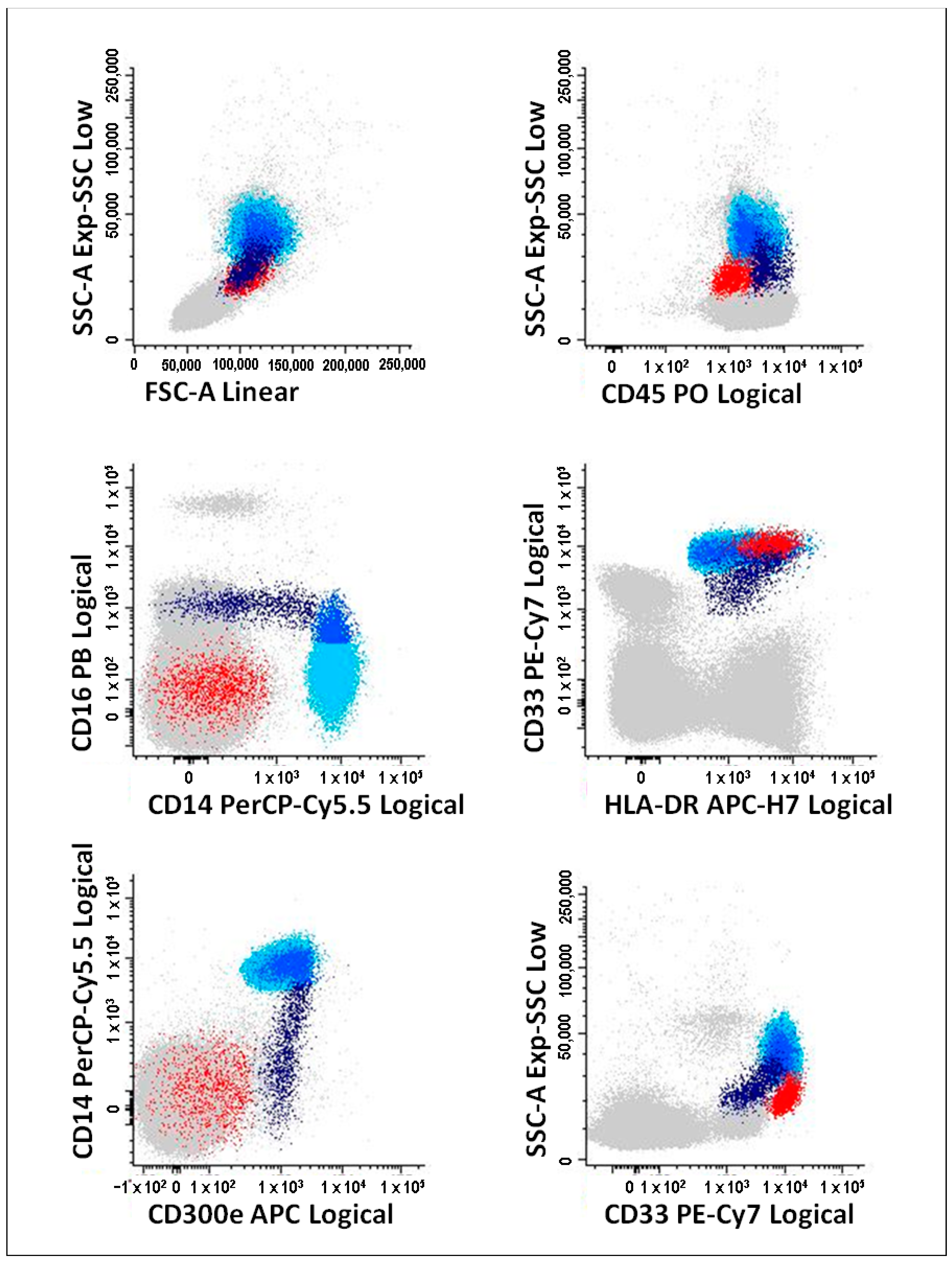

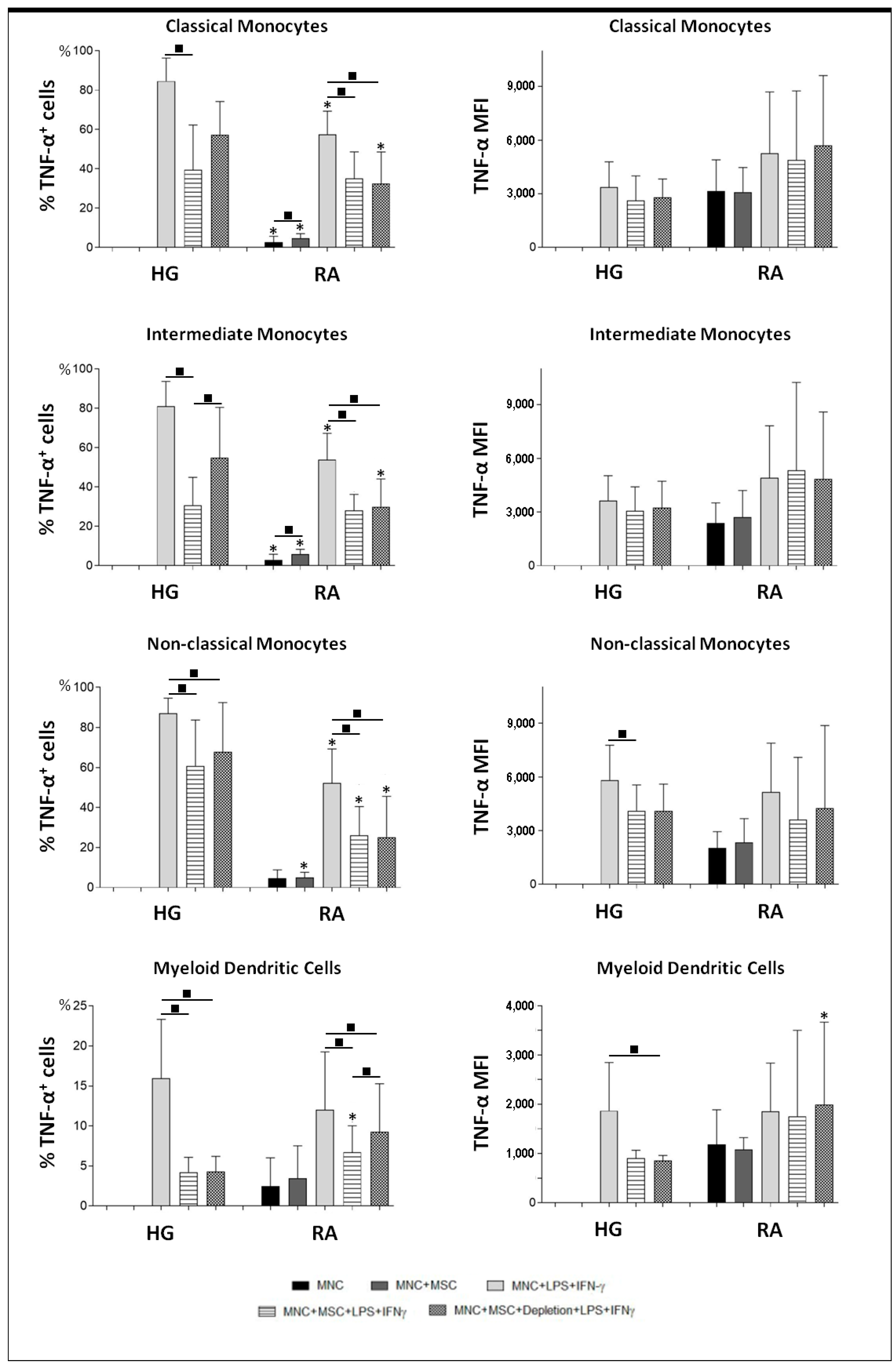
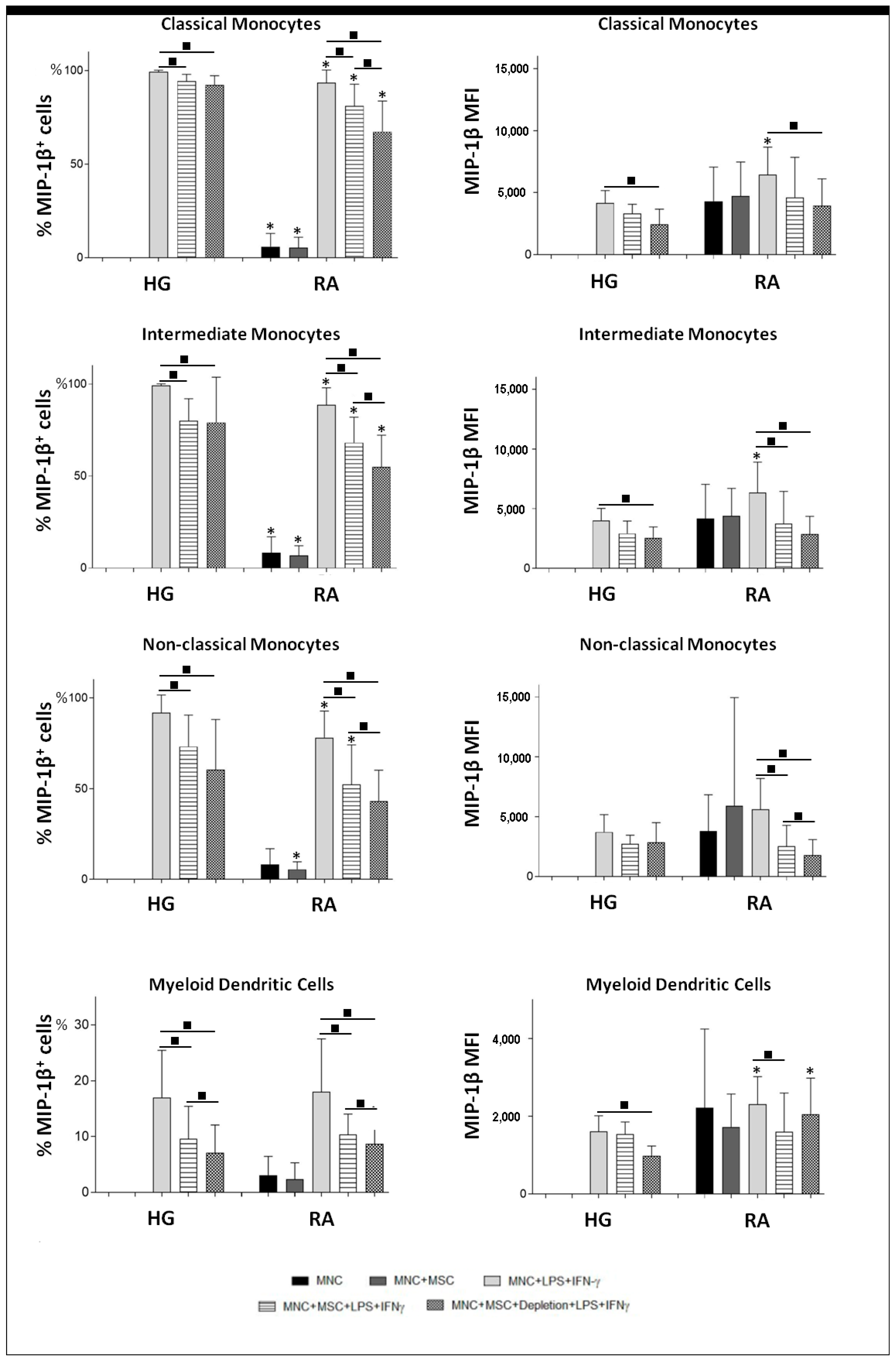


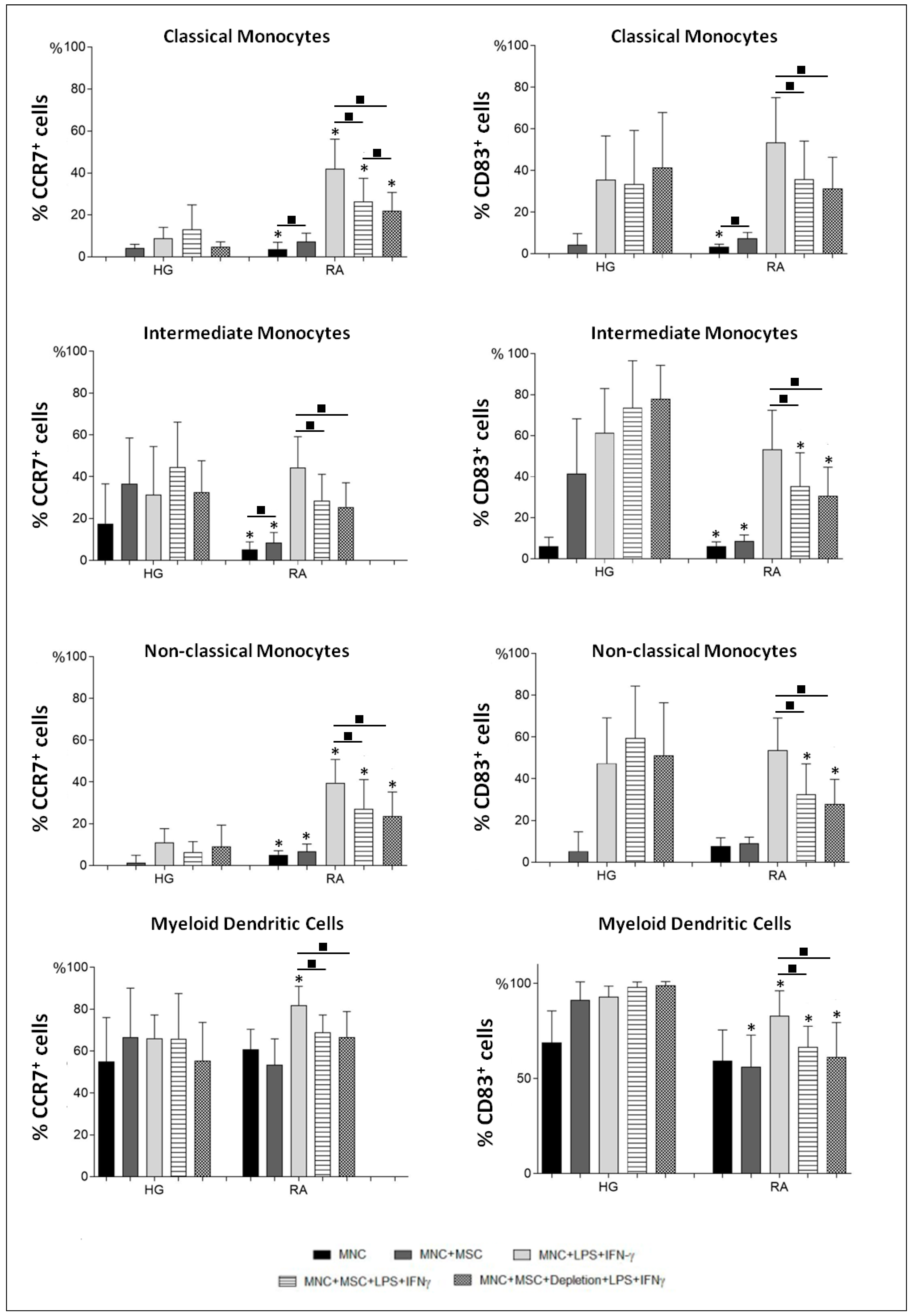
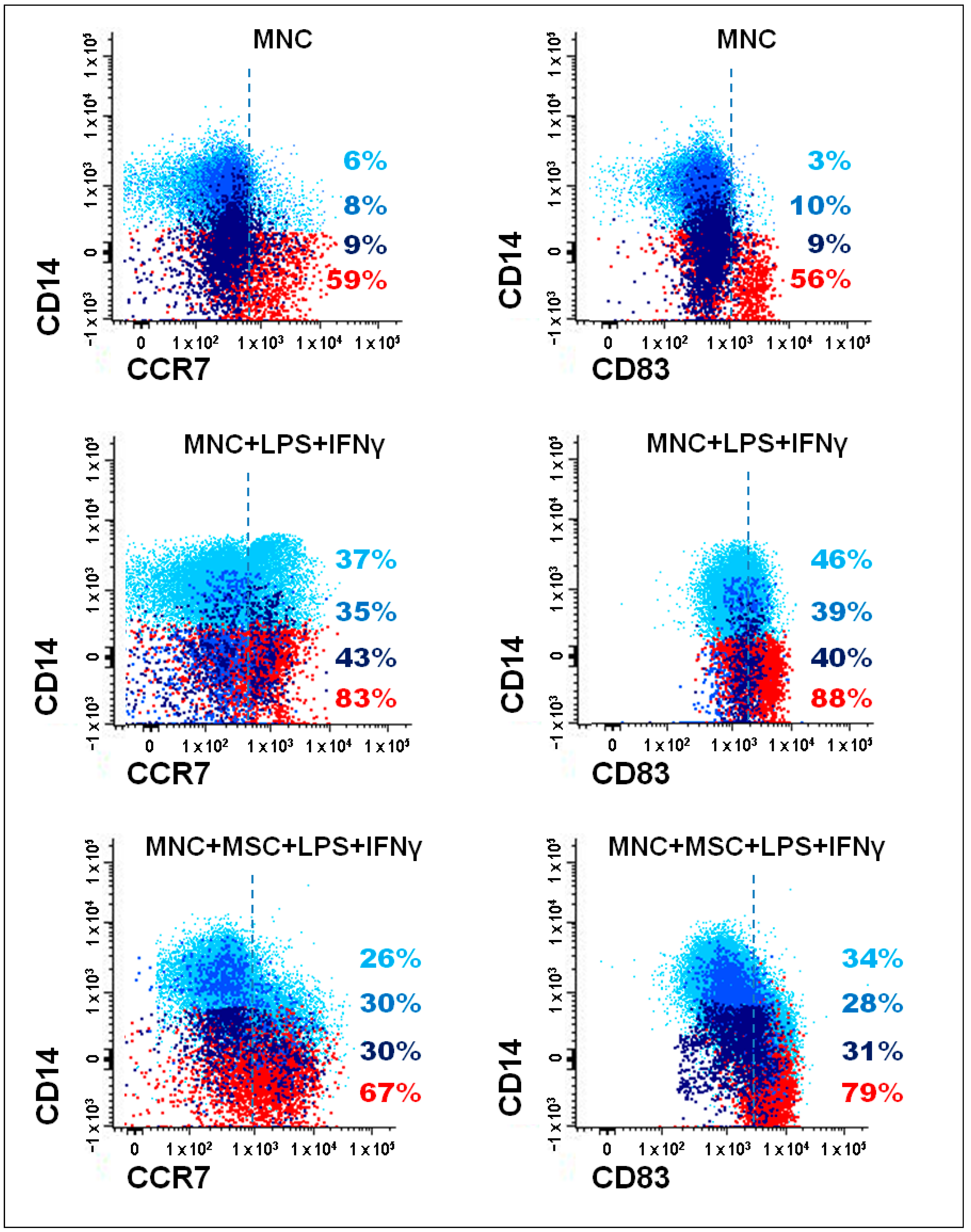
| Fluorochromes | ||||||||
|---|---|---|---|---|---|---|---|---|
| Tubes | PB | PO | FITC | PE | PerCP-Cy5.5 | PE-Cy7 | APC | APC-H7 |
| 1 | CD16 BD Pharmingen 3G8 | CD45 Invitrogen HI30 | CD83 Beckman Coulter HB15a | CCR7 BD Pharmingen 3D12 | CD14 BD Pharmingen M5E2 | CD33 Beckman Coulter D3HL60.251 | CD300e Immunostep SL UP-H2 | HLA-DR BD L243 |
| 2 | CD16 BD Pharmingen 3G8 | CD45 Invitrogen HI30 | cyTNF-α BD Pharmingen MP6-XT22 | cyMIP-1β BD Pharmingen D21-1351 | CD14 BD Pharmingen M5E2 | CD33 Beckman Coulter D3HL60.251 | CD300e Immunostep SL UP-H2 | HLA-DR BD L243 |
| 3 | CD16 BD Pharmingen 3G8 | CD123 Beckman Coulter SSDCL Y107D2 | CD14 BD Pharmingen M5E2 | CD33 Beckman Coulter D3HL60.251 | CD300e Immunostep SL UP-H2 | HLA-DR BD L243 | ||
Publisher’s Note: MDPI stays neutral with regard to jurisdictional claims in published maps and institutional affiliations. |
© 2022 by the authors. Licensee MDPI, Basel, Switzerland. This article is an open access article distributed under the terms and conditions of the Creative Commons Attribution (CC BY) license (https://creativecommons.org/licenses/by/4.0/).
Share and Cite
Laranjeira, P.; Pedrosa, M.; Duarte, C.; Pedreiro, S.; Antunes, B.; Ribeiro, T.; dos Santos, F.; Martinho, A.; Fardilha, M.; Domingues, M.R.; et al. Human Bone Marrow Mesenchymal Stromal/Stem Cells Regulate the Proinflammatory Response of Monocytes and Myeloid Dendritic Cells from Patients with Rheumatoid Arthritis. Pharmaceutics 2022, 14, 404. https://doi.org/10.3390/pharmaceutics14020404
Laranjeira P, Pedrosa M, Duarte C, Pedreiro S, Antunes B, Ribeiro T, dos Santos F, Martinho A, Fardilha M, Domingues MR, et al. Human Bone Marrow Mesenchymal Stromal/Stem Cells Regulate the Proinflammatory Response of Monocytes and Myeloid Dendritic Cells from Patients with Rheumatoid Arthritis. Pharmaceutics. 2022; 14(2):404. https://doi.org/10.3390/pharmaceutics14020404
Chicago/Turabian StyleLaranjeira, Paula, Mónia Pedrosa, Cátia Duarte, Susana Pedreiro, Brígida Antunes, Tânia Ribeiro, Francisco dos Santos, António Martinho, Margarida Fardilha, M. Rosário Domingues, and et al. 2022. "Human Bone Marrow Mesenchymal Stromal/Stem Cells Regulate the Proinflammatory Response of Monocytes and Myeloid Dendritic Cells from Patients with Rheumatoid Arthritis" Pharmaceutics 14, no. 2: 404. https://doi.org/10.3390/pharmaceutics14020404








